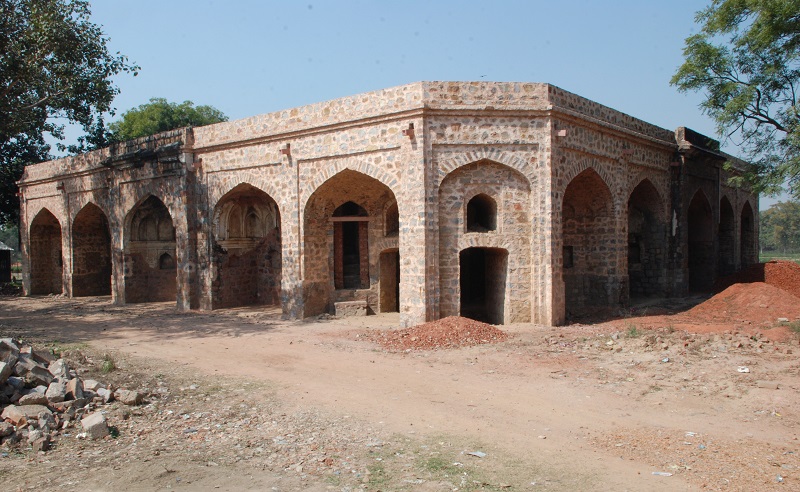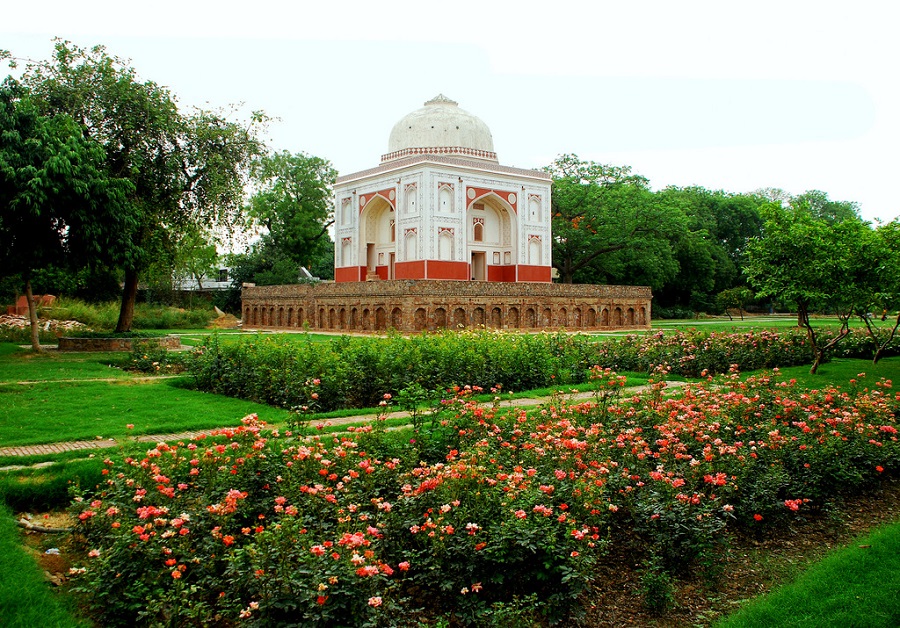Delhi: S
(→Sunder Nursery) |
(→Sunder Nursery) |
||
| Line 107: | Line 107: | ||
By noon, work begins on the evening snacks -samosa, kachori and jaleba (larger version of jalebi) -which are served till late in the night. Between them, the brothers manage the shop from morning till night. With their kids moving on to other vocations, Anil seems unsure about who would carry on the legacy of their father. | By noon, work begins on the evening snacks -samosa, kachori and jaleba (larger version of jalebi) -which are served till late in the night. Between them, the brothers manage the shop from morning till night. With their kids moving on to other vocations, Anil seems unsure about who would carry on the legacy of their father. | ||
| + | |||
| + | |||
| + | =Sultanpur= | ||
| + | [http://epaperbeta.timesofindia.com/Article.aspx?eid=31808&articlexml=CAPITALS-CHAUPALS-Sultanpur-Hungry-for-rent-Sultanpur-swallowed-13102015010056 ''The Times of India''], Oct 13 2015 | ||
| + | [[File: Village chaupal, Sultanpur, Delhi.jpg|Village chaupal, Sultanpur, Delhi; Picture courtesy: [http://epaperbeta.timesofindia.com/Article.aspx?eid=31808&articlexml=CAPITALS-CHAUPALS-Sultanpur-Hungry-for-rent-Sultanpur-swallowed-13102015010056 ''The Times of India''], Oct 13 2015|frame|500px]] | ||
| + | |||
| + | [[File: Sultanpur, Delhi.jpg|Sultanpur, Delhi; Picture courtesy: [http://epaperbeta.timesofindia.com/Article.aspx?eid=31808&articlexml=CAPITALS-CHAUPALS-Sultanpur-Hungry-for-rent-Sultanpur-swallowed-13102015010056 ''The Times of India''], Oct 13 2015|frame|500px]] | ||
| + | |||
| + | Risha Chitlangia | ||
| + | |||
| + | '''Sultanpur - Hungry for rent, Sultanpur swallowed whole by tenants''' | ||
| + | | ||
| + | Every afternoon, the elders of Sultanpur village in southwest Delhi sit down to play cards in their chaupal.In the evening, children play games in the space around the 1930s-era building. “Our fields are gone; there are no parks or open spaces left in the village,“ rues Dharamvir, an old-timer. | ||
| + | Change has come to Sultanpur rather suddenly .The village was late to commercialize, but in the past few years it has single-mindedly chased rent--hemming itself in between showrooms and a residential colony . | ||
| + | |||
| + | One of Delhi's older villages, Sultan pur is advanta geously lo cated on the Me hrauli-Gurgaon Road. It started commercializing around the same time as Ghitorni but remained an also-ran until a few years ago when it became a magnet for high-end home furnishing brands and the production units-cum-studios of designers. Many farmhouses have also been built in the village. | ||
| + | |||
| + | Drawn by its cheaper rents, many home furnishing and designer brands relocated to Sultanpur from Saidul-Ajaib near Saket. “It is cheaper and we got a bigger space,“ said an employee of a furnishing brand. Offices of NGOs and corporates have also moved to Sultanpur. | ||
| + | |||
| + | The colony at the back draws people w h o w o r k in Gur gaon but can't afford to live there. “The rent is cheap and going from Sultanpur to Gurgaon by Metro takes hardly 15-20 minutes,“ said Sameer Singh, who works in Gurgaon. | ||
| + | |||
| + | Surrounded by swank multi-storey buildings, Sultanpur today is a village facing an identity crisis.Villagers like to do things the old community-centric way . Religious functions, wedding celebrations and condolence meetings are held at the chaupal. But with the open spaces gone and the infrastructure crumbling, many old families are selling out. “The front and the back of the village get all the facilities. No one listens to us.Sewers overflow and taps remain dry . We have to use pumps. This wasn't the case till a few years ago,“ said Tejpal, a village elder. | ||
| + | |||
| + | The village's roads are congested as the colony at the back uses the same en try . “If there's a fire, there is no alternative route for fire tenders,“ said Chohal Singh, a retired school teacher. | ||
Revision as of 14:41, 25 October 2015
This is a collection of newspaper articles selected for the excellence of their content. |
Contents |
Sadar Bazar
Nand Di Hatti
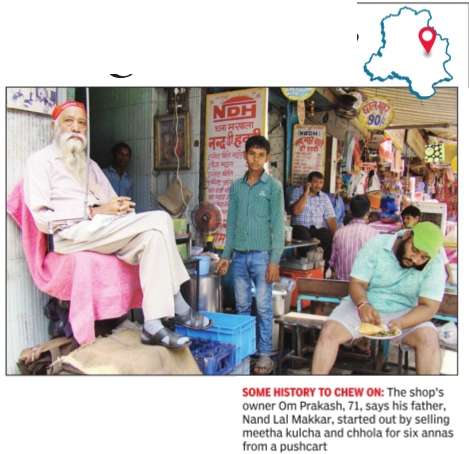
The Times of India, Sep 12 2015
Sujith Nair Nand Di Hatti has been drawing generations of Delhiites with lip-smacking chhola-bhaturas
Chhola bhatura -the sight and smell of this sinfully flavour some combination can kill any diet plan. Nand Di Hatti, nestled in the milling lanes of Old Delhi's Sadar Bazaar, is among the best places for a plateful of this spicy delight.This eatery has been drawing generations of Delhiites with its fluffy bhaturas and spiced chickpeas. The shop's secondgeneration owner, 71-year-old Om Prakash, says his father, Nand Lal Makkar, initially sold meetha kulcha and chhola for six annas from a pushcart in Sadar Bazaar. He had moved to Delhi along with his family from Rawalpindi during Partition.
Nand Lal set up the shop in mid-70s and started serving bhaturas instead because Karol Bagh's Bhasin Bakers which supplied meetha kulcha stopped production -it no longer had wo rk e r s s k i l l e d enough to undertake the baking process. “Red in colour, the meetha kulcha is bigger and three times costlier than the normal one,“ says Gajendra Bhasin, the current owner of Bhasin Bakers. His grandfather sold meetha kulcha in Rawalpindi and after Partition set up shop in Karol Bagh.
In the early 90s, Nand Lal's shop was split between his two sons. Om Prakash, the second son, now runs Nand Di Hatti along with his sons, while his nephew, Bharat, 44, sits in the second shop called Nand Bhature Wale Di Hatti.
Made in desi ghee without onion, Nand Lal's chhola bhaturas are served with aloo, chillies and mango pickle.Bharat's day starts at 3am when he starts cooking chana in his kitchen, which he shares with his cous h he shares with his cous ins. The chana, which is not soaked as is the nor m, is cooked with spices over low fire for five hours. Slow cooking, Bharat says, ensures that the chickpea's skin stays intact. Anubhav Sapra, who conducts food walks in the city, says his parents maintain that Nand's chhola bhatura has remained consistently delicious over the last 30 years. “Nand mixes sooji with maida while making the bhaturas. This keeps them light on the tummy,“ says Sapra. Bharat says he tried setting up similar shops in West Dehli's Hari Nagar and Ramesh Nagar, but had to fold up within six months. Om Prakash, too, had to wind up his second outlet in Paharganj within a year.
Both shops also sell chana masala in packets for patrons who want to replicate the magic. Mahesh Khanna, 70, the second-generation owner of Khanna Stationery Mart in Sadar Bazaar, remembers eating Nand's chhola and meetha kulcha in the early 60s. “They used to sell it for 50 paise. Now it costs Rs 90,“ he says.
Food historian Pushpesh Pant says Delhi had a culture of chaats, kulcha and mutter. “Chhola bhatura came in with the refugees during Partition and soon replaced kulcha and mutter from the scene.“
Shahpur Jat
The Times of India, Aug 22 2015
Dharvi Vaid
A village sets trend with style potpourri
Shahpur Jat, an urban village, has a swagger all its own. This stylish retail hub in south Delhi prides itself on its rural atmosphere that only accentuates the cutting edge fashion that it offers to discerning customers Colourful and quirky Shah pur Jat is anachronistic --in reverse. Its dirt lanes are boisterous and redo lent of rural India and yet this village in south Delhi has some of the most modern de signer ware on sale. Abutting the ruins of Alauddin Khilji's medieval Siri Fort Shahpur Jat once used to be an affordable production hub for rookie fashion designers. Today, it has transformed into a popular high-fashion retail area that melds the traditional with the modern. In the heart of the urban village is Jungi House, whose narrow lanes colourfully announce the presence of niche designer labels such as Liz Paul, Rahul and Anushka, Preeti Mohan, Bhumika Grover, Monika and Nidhi, Akshay Wadhwa and Rajat Suri. The wedding season can be a riot here, with lehangas, anarkalis and saris that have newness and flamboyance woven into them. And if it's a foreign look they are contemplating, there are stores like House of Blondie and Les Parisiennes to fulfil their fantasy. Men too can try out the array of fine wedding apparel here, from formals to innovative Indo-Western numbers whose prices can go up to Rs 50,000.
However, it is not only for wedding outfits that the style seekers congregate at this village. Designer Liz Paul says customers come hunting for traditional party wear too. “The best thing about Shahpur Jat is that in a single place you can get everything, and because most of the things on sale are designer pieces, they are unique too,“ she says.
An example of unique is the m e n swe a r at UNIT by Rajat Suri. The de signer has bor rowed the me tallic patterns that have been in vogue in women's fashion for some time and incorporated them rather boldly on solemn blazers and Nehru jackets. “Designers here excel in making boring office wear look stylish,“ quips Suri.
And then there are the jewellery shops. The bling in the showcases blend the old and the new, the tribal and the avant garde. No wonder, the chand balis and jhumkis, the kundan and the polki here are statements in themselves. What is more, if you want any particular piece customized, the stores are more than willing to ensure the glitter is uniquely yours.
“At Preeti Mohan's store you can even get your old watch customized into a beautiful ornament with gems of your liking,“ says Kanika Behl, who regularly shops at Shahpur Jat.“Whether you wear it with a maxi dress or an understated sari, it fits in as an exemplar of style.“ Walk around, and you will also find kitschy de signs incorporated into bedsheets, lampshades, cushion covers and wall hangings.
There is a tangible swagger about the place, perhaps because it is popular among budding designers who are just beginning to experiment with their labels. “Earlier designers only had small fabrication centres here,“ says Gau rav Jagtiani, who has had a produc tion unit in the village for seven years now, “but new designers have set up their retail stores here and are expanding the market.“
The restaurants in the village have joined in the fun with Bohe mian inspiration. “It is a place that is welcoming of all,“ says Sumit Singh, who opened Cafe Red with three other friends, all bankers. “We wanted a place where working people like us could just lounge and relax over a cup of coffee. Shahpur Jat topped our list because it has a very relaxing ambience.“ Like Cafe Red, there are many other theme restaurants that offer cuisines from India and across the world.
“The architecture and the gallies here give you the flavour of rural India,“ points out Jagtiani. “These elements are interpreted by the designers in their work.“ And that is what makes Shahpur Jat a village out of time.
Shalimar Bagh
Sheesh Mahal
The Times of India 2013/07/04
See the pictures and graphics
Shamnath Marg
Bungalow no. 33
Manash Gohain, The Times of India Jun 19 2015 DDC gets house where ministers fear to stay
The “unlucky bungalow“--33, Shamnath Marg--which no minister or bureaucrat has ever willfully opted for, was made the headquarters of Delhi Dialogue Commission (DDC).
The building, which had been the residence of the then CM Madan Lal Khurana before the Hawala scam forced him to demit his office, was refused by two other former CMs--Sahib Singh Verma and Sheila Dikshit--apparently due to Vaastu incompatibility .
However, a few like former power secretary Shakti Sinha consider this a great place to stay . He said he “would love to stay there gain“. Rejected by Congress and BJP for many years, AAP government, now finds this a perfect location for holding policy dialogue.
Considered a jinxed location by many , the bungalow was the official residence of the chief minister of Delhi till 19 years ago. Built on a 2,000sq ft plot, the bungalow has been there since the Raj era. The first CM (1952) of Delhi, Chaudhary Brahm Prakash, had lived here for a brief period. However, things didn't “go well“ and he could not complete his term as CM.
Thereafter, the bungalow remained vacant for a long time. In 1993, the building was the residence of former CM Khurana. This was followed by a series of rejections with politicians including Dikshit and many bureaucrats turning it down who considered the house “inauspicious“.
Sitaram Bazaar
Ram SwarupHalwai
The Times of India, Oct 03 2015
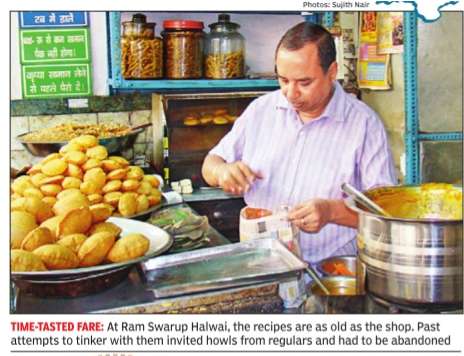

Sujith Nair
At Sitaram Bazaar, a kingly breakfast awaits you at an old, rustic halwai shop
It's been around for 80 years. And not much has changed in Ram Swarup Halwai, one of Sitaram Bazaar's oldest shops, in all these decades. It still has a rustic air about it. Those lucky enough to stay in its vicinity often turn up for a breakfast of sumptuous bedmi aloo and nagori halwa. For others, it is a two-minute walk from Chawri Bazaar Metro Station. The Mittal brothers who own the shop serve bedmi on dhak tree leaves, which come from Faridabad on vans that transport newspapers.
ith aloo subzi, methi The bedmi comes with aloo subzi, methi chutney , pickled carrot and fresh chilli.This is followed by nagori halwa -mini, crispy suji pooris are punctured and stuffed with ghee-dripping suji halwa; they're ideally eaten the golgappa way .
From 8am to noon, bedmi and suji pooris fly out of the kadhai and are packed along with subzi and halwa as takeaways. Two tables in front of the shop serve customers who have to elbow for space with people brushing past on the street.
The brothers are in their fifties. Anil Kumar, the younger Mittal,is a reluctant talker. Ajit, the elder one, even less so -only gesturing, with a cigarette sticking out of his lips. But with skills that they have inherited from their father, who started as a halwai in Lal Kuan and later set up this shop, it's their dishes that do most of the talking.
Their father Ram Swarup, after whom the shop is named, opened it around the time when Kamala Nehru's family lived in the neighbourhood. Anil says he still remembers a rainy day , in the early '80s, when then Prime Minister Indira Gandhi went past his shop to see her maternal grandparents' house in Dhamani Market.“The road was quite a puddle and you should have seen the scared faces of the nagar nigam officials,“ he says with glee.
Even today, the rains recreate the '80s! Former residents of the area still come from all over the city to buy sweets, specially on Holi and Diwali, Anil says. The brothers have tried their best not to tinker with their fa ther's recipes. The sabzi is still made from unpeeled potatoes. Once, an experiment to use peeled aloos met with howls of protest from regulars and had to be abandoned post haste. However, subzi and nagori are now served in thermocol plates instead of pattal (leaves) to avoid messy leaks.
By noon, work begins on the evening snacks -samosa, kachori and jaleba (larger version of jalebi) -which are served till late in the night. Between them, the brothers manage the shop from morning till night. With their kids moving on to other vocations, Anil seems unsure about who would carry on the legacy of their father.
Sultanpur
The Times of India, Oct 13 2015

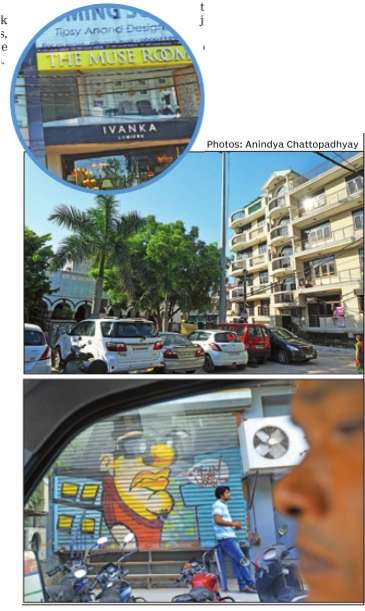
Risha Chitlangia
Sultanpur - Hungry for rent, Sultanpur swallowed whole by tenants Every afternoon, the elders of Sultanpur village in southwest Delhi sit down to play cards in their chaupal.In the evening, children play games in the space around the 1930s-era building. “Our fields are gone; there are no parks or open spaces left in the village,“ rues Dharamvir, an old-timer. Change has come to Sultanpur rather suddenly .The village was late to commercialize, but in the past few years it has single-mindedly chased rent--hemming itself in between showrooms and a residential colony .
One of Delhi's older villages, Sultan pur is advanta geously lo cated on the Me hrauli-Gurgaon Road. It started commercializing around the same time as Ghitorni but remained an also-ran until a few years ago when it became a magnet for high-end home furnishing brands and the production units-cum-studios of designers. Many farmhouses have also been built in the village.
Drawn by its cheaper rents, many home furnishing and designer brands relocated to Sultanpur from Saidul-Ajaib near Saket. “It is cheaper and we got a bigger space,“ said an employee of a furnishing brand. Offices of NGOs and corporates have also moved to Sultanpur.
The colony at the back draws people w h o w o r k in Gur gaon but can't afford to live there. “The rent is cheap and going from Sultanpur to Gurgaon by Metro takes hardly 15-20 minutes,“ said Sameer Singh, who works in Gurgaon.
Surrounded by swank multi-storey buildings, Sultanpur today is a village facing an identity crisis.Villagers like to do things the old community-centric way . Religious functions, wedding celebrations and condolence meetings are held at the chaupal. But with the open spaces gone and the infrastructure crumbling, many old families are selling out. “The front and the back of the village get all the facilities. No one listens to us.Sewers overflow and taps remain dry . We have to use pumps. This wasn't the case till a few years ago,“ said Tejpal, a village elder.
The village's roads are congested as the colony at the back uses the same en try . “If there's a fire, there is no alternative route for fire tenders,“ said Chohal Singh, a retired school teacher.
Sunder Nursery
RETURN OF THE MUGHAL
Sunder Nursery was a Mughal garden once, and will be again in
Richi Verma | TNN
The Times of India 2013/08/31
The Sunderwala Burj, sleeps undisturbed behind the tall gates of Sunder Nursery just across the road. Few know the nursery as anything more than a seedbed for the trees and flowers in Lutyens’ Delhi, but that is set to change soon.
Quietly, the sprawling property is being transformed into an authentic Mughal garden laid around a central axis with monuments, fountains, water bodies and a large variety of tree and bird species. The project’s landscape planner, Mohammed Shaheer, says the aim is to conserve the environment and create a “major landscaped space” aligning nature and utility in a garden.
The Aga Khan Trust for Culture (AKTC), is partnering Archaeological Survey of India and the site owner, Central Public Works Department, in the project
The project was conceived while AKTC was restoring the gardens of Humayun’s Tomb during 1997-2003. When they are completed in 2015, the Sunder Nursery gardens will cover 100 acres across the nursery and the adjoining Batashewala complex. Shaheer says the gardens will have a microhabitat zone for plants found on Delhi’s ridge, river banks, plains and other zones.
Edged by nine mounds, the microhabitat zone will replicate Delhi’s original landscape to increase environmental awareness among the 3 lakh schoolchildren who visit Humayun’s Tomb every year. AKTC has recorded 1,800 mature trees of more than 200 species at the nursery on a geographic information system (GIS) and planted another 100-odd species. “Biodiversity studies in 2012 documented 54 species of resident birds and 24 species of butterflies,’’ said an official.
Besides the Sunderwala Burj, the nursery also has eight early-Mughal era monuments that have been restored after years of neglect. Three of them—Sunderwala Burj, Lakkarwala Burj and Sunderwala Mahal—have been declared monuments of national importance by the ASI. However, other structures, including ancient wells, a Mughal pavilion, a mosque and several graveyards are unprotected but equally striking. Two monuments in the adjunct Bateshewala complex are also with ASI.
For the complex as a whole, the changes mark a return to past glory. Before the British turned it into a nursery in 1913, it was called Azim Bagh. “Historically, the entire area from Humayun’s Tomb to Millennium Park (along the Yamuna) was a Mughal garden,” says Ashok Khurana, retired director general of CPWD in whose tenure the project was conceived.
AKTC has offered to manage Sunder Nursery until it becomes financially sustainable. “Discussions for postproject management of the park are now in an advanced state with AKTC underwriting all management and maintenance costs for 10 years,’’ said Ratish Nanda, project director of AKTC. Already, parallels are being drawn between the gardens and New York’s iconic Central Park.


